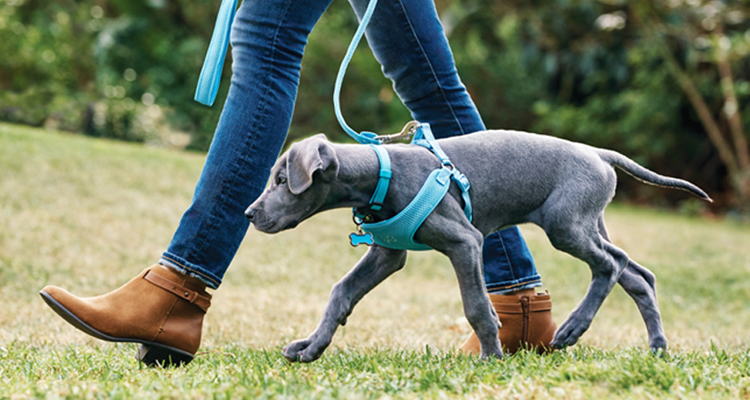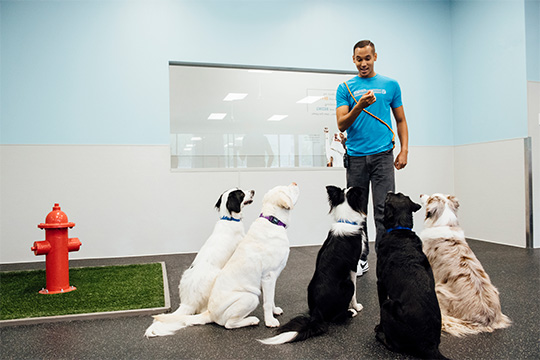Dog Training Near Me: Find Local Experts for Customized Training Programs
Dog Training Near Me: Find Local Experts for Customized Training Programs
Blog Article
Newbie's Guide to Successful Canine Training at Home
Effectively training a pet dog at home calls for a nuanced understanding of canine actions and efficient interaction approaches. Establishing clear training goals, utilizing high-grade benefits, and maintaining consistency throughout household members are important elements. Integrating training into everyday regimens can enhance both engagement and retention.
Comprehending Pet Behavior
Comprehending canine actions is important for effective training and cultivating an unified partnership in between humans and their canine friends - Puppy Training. Pet dogs communicate mainly through body language, articulations, and faces, making it vital for proprietors to interpret these signals properly. Identifying behaviors such as tail wagging, roaring, or trembling can provide insights into a canine's emotion and purposes
Additionally, understanding the natural reactions of pet dogs, such as their pack way of thinking, helps proprietors develop leadership duties within the house. This is crucial for producing an organized setting where dogs feel safe and are much more responsive to training. Pets are likewise influenced by their socializing experiences; very early direct exposure to numerous settings, people, and other pets can substantially shape their actions later in life.
Typical behavioral problems, such as aggression, anxiety, or excessive barking, typically come from misunderstandings or unmet needs. Observing and dealing with these issues without delay can stop escalation and make sure a positive training experience. By cultivating a deep understanding of pet dog habits, owners can tailor their training techniques to fit their canine friends, eventually leading to a mannerly and satisfied pet dog.

Essential Training Devices
A well-equipped training room can significantly boost the performance of pet training in the house. Important training tools make sure that both the dog and the instructor can engage in efficient sessions that cultivate understanding and bonding.

Buying a durable chain and a comfortable, well-fitting collar or harness is important for security and control. These tools help develop limits and make sure the dog continues to be safe during training. In addition, a designated training location, free from disturbances, help concentration for both the pet dog and the fitness instructor.
Educating aids such as training pads, cones, or agility devices can likewise improve the experience by presenting selection and challenges. Last but not least, having a note pad or digital application for tracking development can be very useful, allowing you to note successes and locations for renovation. Utilizing these important tools will produce a favorable training environment and lay the structure for effective discovering.
Producing a Training Regimen
Establishing a consistent training regimen is crucial for effective dog training in your home. A well-structured regular not just aids in enhancing wanted habits however likewise provides your dog with a feeling of security and predictability. To create a reliable training routine, begin by determining certain training goals, such as standard commands, leash strolling, or house-training.
Select a designated time every day for training sessions, ideally when your pet dog is alert and receptive. Procedure must be short, roughly 5 to 15 minutes, to keep emphasis and avoid fatigue. Uniformity in timing and atmosphere will boost your pet's discovering experience.
Incorporate training right a knockout post into daily activities to reinforce skills. For instance, technique commands throughout walks or mealtime, which integrates learning into all-natural regimens. In addition, stay versatile and adjust the routine as essential, fitting your canine's power degrees and state of mind.
Positive Support Strategies

When carrying out positive support, it is important to select benefits that are inspiring for your canine. High-value treats, such as little pieces of chicken or cheese, can be particularly reliable during training sessions. In addition, differing the rewards can maintain your canine's passion and interest.
Begin with simple commands, like "rest" or "stay," and slowly progression to much more intricate tasks. Uniformity is vital; guarantee that all household participants use the exact same commands and incentive systems to avoid complication.
In addition, it is important to stay patient and avoid frustration. Pet dogs, like human beings, learn at their own speed. By cultivating a helpful training environment with favorable support, you can improve your dog's learning experience while reinforcing the bond between you and your furry friend, laying the foundation for successful training outcomes.
Common Educating Obstacles
While educating a pet dog in your home can be a fulfilling experience, it typically comes with a set of typical obstacles that can check both persistence and uniformity. One common problem is diversion. Pet dogs might end up being quickly sidetracked by sounds, motions, or also scents in their environment, making it hard to preserve their emphasis during training sessions.
Another obstacle is disparity in commands and support. If family members use different signs or incentives, it can confuse the pet Visit Your URL dog and impede progress. Developing a unified strategy is crucial for reliable interaction.
Furthermore, canines can experience disappointment or anxiety, particularly if they do not comprehend what is anticipated of them. This can cause undesirable actions, such as barking or chewing.
Lastly, the timing of reinforcement is vital. Postponed benefits can reduce the efficiency of favorable reinforcement, as pets may fail to attach read the full info here the habits with the incentive.
Getting over these difficulties needs dedication, clear communication, and an organized training plan - Puppy Training. Recognizing and attending to these usual challenges will certainly pave the way for a much more pleasurable and effective training experience at home
Final Thought
In final thought, successful dog training at home demands a thorough understanding of canine actions and reliable interaction approaches. By developing clear training objectives and utilizing top notch deals with together with favorable support, the training procedure comes to be more satisfying for both the instructor and the canine.
Developing a consistent training routine is crucial for effective pet training at home.Positive support methods are basic to efficient pet training, promoting wanted behaviors via rewards instead than penalty. By promoting an encouraging training atmosphere via positive reinforcement, you can boost your pet dog's learning experience while enhancing the bond in between you and your hairy companion, laying the foundation for effective training results.
In conclusion, successful pet training at home necessitates a detailed understanding of canine actions and effective communication strategies. By establishing clear training objectives and making use of premium deals with together with favorable support, the training procedure comes to be more gratifying for both the fitness instructor and the canine.
Report this page